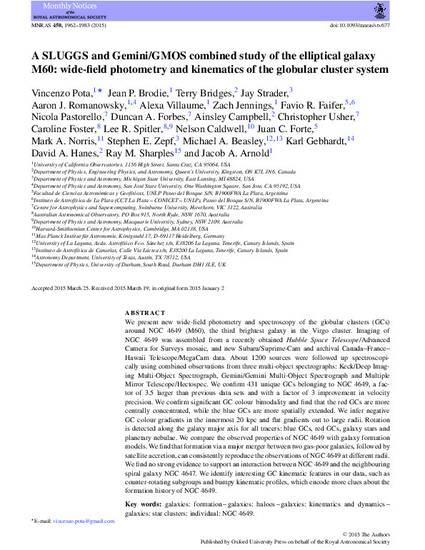
Article
A SLUGGS and Gemini/GMOS combined study of the elliptical galaxy M60: wide-field photometry and kinematics of the globular cluster system
Monthly Notices of the Royal Astronomical Society
(2015)
Abstract
We present new wide-field photometry and spectroscopy of the globular clusters (GCs) around NGC 4649 (M60), the third brightest galaxy in the Virgo cluster. Imaging of NGC 4649 was assembled from a recently obtained Hubble Space Telescope/Advanced Camera for Surveys mosaic, and new Subaru/Suprime-Cam and archival Canada–France–Hawaii Telescope/MegaCam data. About 1200 sources were followed up spectroscopically using combined observations from three multi-object spectrographs: Keck/Deep Imaging Multi-Object Spectrograph, Gemini/Gemini Multi-Object Spectrograph and Multiple Mirror Telescope/Hectospec. We confirm 431 unique GCs belonging to NGC 4649, a factor of 3.5 larger than previous data sets and with a factor of 3 improvement in velocity precision. We confirm significant GC colour bimodality and find that the red GCs are more centrally concentrated, while the blue GCs are more spatially extended. We infer negative GC colour gradients in the innermost 20 kpc and flat gradients out to large radii. Rotation is detected along the galaxy major axis for all tracers: blue GCs, red GCs, galaxy stars and planetary nebulae. We compare the observed properties of NGC 4649 with galaxy formation models. We find that formation via a major merger between two gas-poor galaxies, followed by satellite accretion, can consistently reproduce the observations of NGC 4649 at different radii. We find no strong evidence to support an interaction between NGC 4649 and the neighbouring spiral galaxy NGC 4647. We identify interesting GC kinematic features in our data, such as counter-rotating subgroups and bumpy kinematic profiles, which encode more clues about the formation history of NGC 4649.
Keywords
- galaxies: formation,
- galaxies: haloes,
- galaxies: kinematics and dynamics,
- galaxies: star clusters: individual: NGC 4649
Disciplines
Publication Date
June, 2015
DOI
10.1093/mnras/stv677
Publisher Statement
This article has been accepted for publication in Monthly Notices of the Royal Astronomical Society ©: 2015 The Authors. Published by Oxford University Press on behalf of the Royal Astronomical Society. All rights reserved.
This article can also be found online at the following link: http://dx.doi.org/10.1093/mnras/stv677
Citation Information
Vincenzo Pota, Jean P. Brodie, Terry Bridges, Jay Strader, et al.. "A SLUGGS and Gemini/GMOS combined study of the elliptical galaxy M60: wide-field photometry and kinematics of the globular cluster system" Monthly Notices of the Royal Astronomical Society Vol. 450 Iss. 2 (2015) p. 1962 - 1983 ISSN: 1365-2966 Available at: http://works.bepress.com/aaron_romanowsky/81/
